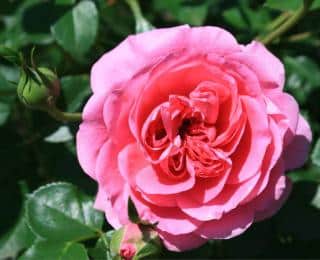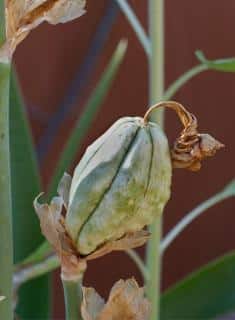

In the world of nature-lovers and horticulture, certain plants are marked with a ® or ™ symbol. This is the mark of a plant patent.
Does this mean nature is up for grabs by anyone with the ambition to own it?
Let’s check what it means, both to the letter and to the spirit of the letter.
Some of your own houseplants or garden treasures may actually be patented already!
Read also:
A plant patent attributes the plant patent owner rights to exclusive commercial gain for a specific plant variety.
Basically, a person or entity that files for a plant patent holder controls who can earn from propagating and selling that particular plant variety.
The patent is usually a number that refers to particular entry in a database. This database is managed by each country’s Intellectual Property agency or administration. You should always contact them for more details on how to patent a plant and other legal information.
A cultivated plant is one that is grown already either in a field or in a greenhouse, eventually a laboratory. Plants found in the wild cannot be patented. A farmer, planting his own seeds, who discovers a sport or a unique vegetable in his or her field may file for a patent for that new variety.
Any type of vegetative propagation, (cultivar cloning, cuttings, perennial division…) is declared illegal. Cloning or vegetative propagation reproduces the plant with the exact genetic material. Propagation for your own personal use is also prohibited in the legal definition.
However, in most cases seeds the plant may bear are not protected. This is because seeds arise from sexual reproduction. Offspring will necessarily have different characteristics than the parent plant. Since they will be genetically different from the protected parent plant, seed-grown offspring normally aren’t covered in the initial patent.
Of course, the description is checked to verify that this is the first time a patent is filed for this plant.
 As described above, identifying a specific variety and learning how to grow and propagate it is a lot of work. Usually, years of work are needed to identify and properly describe a special, unique variety.
As described above, identifying a specific variety and learning how to grow and propagate it is a lot of work. Usually, years of work are needed to identify and properly describe a special, unique variety.
Patenting the plant helps guarantee revenue for the breeder. It’s a way to “pay back” the time, work, and expertise. Patents ensure that people who are passionate about growing new plants can actually make a living from it.
If not for patents, people interested in the field wouldn’t be able to dedicate their whole time to their passion. They would have to work a livelihood in a different field to survive and feed their families.
Greedy people could take their discovery and profit from it without sharing back. This disrespects the time and effort put into creating and selecting the unique variety.
As you’ll read in the next part, finding the right cultivar a costly endeavor.
With patents, plant breeding professionals and horticulturists are able to earn from producing unique plants. They have both the resources (time and funds) to develop new plants, and the incentive. Indeed, those passionate people are exactly where they should be to create new plants and streams of income:
To also show that their work will benefit the common good, an upper limit is set as to how long the patent is valid. Once that time span is past, anybody can start propagating the plant and earn from it.
As the patent holder, you decide who is allowed to propagate that exact variety that you developed.
Granting a license to another person or entity means they pay you to grow, market, or sell the patented plant. They pay you a bulk amount and it’s up to them to earn from it. It can be an exclusive license (only them) or a shared license, or anything in between (exclusive for certain time or geographical location).
The other option is royalties. Partners will produce and sell your patented plant, but will give you a commission, a fraction of the sales.
All of this is negotiated constantly, there’s no rule as to what may happen! It’s usually a combination of all three (self-promotion, licensing, royalties).
Example:
Typically, the main advantage of purchasing a patented plant is that you won’t be disappointed.
Indeed, plants with patents were tested and grown in a variety of environments and growing conditions.
Depending on what is advertised, they were proven to be less vulnerable to disease or more prolific flower/fruit bearers than their parent counterparts.
Just as with many things where beauty is involved, you’ll be at the pinnacle of fashion. Marketing hype creates a buzz and getting new sought-after plants helps feel part of a community.
There are a few key points that will hint that a particular plant is a good candidate for patenting.
 Any candidates must combine special properties to be deemed worthy of a patent.
Any candidates must combine special properties to be deemed worthy of a patent.
So only plants that meet all desired characteristics are relevant:
It takes a lot of trial and error to find the right one! Different ways such plants may appear include hybridization, mutations, and cross-pollination.
Blooming, size, fragrance, shape, fruiting are all unique to each plant. Sometimes a particular trait (such as variegated leaves) may disappear when the plant is propagated.
A breeder must thus find that single plant that will constantly “stay the same” even after several rounds of vegetative propagation.
This is the most unsettling part of the decision process. Indeed, most of us gardeners generously give time and efforts to nature and neighbors. Whether we deal with flowers or vegetables, the more we grow, the more we are able to give!
Thinking about earning a profit and blocking others from benefiting of something natural isn’t something we like. It usually draws feelings of anger and raw emotion worse than an invasion of aphids!
Also, part of the joy of creating something wonderful is sharing it to the world. Until the “giving economy” becomes a reality, the best way to go forward is to insert the new wonderful plant onto the current marketplace.
Most plants you might find in your local garden store are actually patented plants.
In the vegetable patch, most plants grown from F1 hybrid seeds are patent-protected. They were selected for their fruiting, disease resistance, and hardiness among other characteristics.
 A garden flower such as Sunpatiens is a patented variety of the generic Impatiens family. It was bred to resist full sun whereas a normal Impatiens prefers part shade.
A garden flower such as Sunpatiens is a patented variety of the generic Impatiens family. It was bred to resist full sun whereas a normal Impatiens prefers part shade.
In terms of cold resistance, for example, the rather common Garvinea is a special Gerbera that was patented for its cold hardiness. A normal gerbera dies at the first frost, but a Garvinea will hibernate and burst forth again in Spring.
Interestingly, although many Iris flowers are patented, the seeds they produce aren’t covered in the patent. This is because the seeds produce offspring that are often wildly different from their parents.
For fruit trees, many of the current varieties on the market aren’t patented. They’re usually produced from cuttings of very old tree families. For example, the Picholine olive tree has been around for centuries. We are now freely benefiting from the work of generations of past breeders who selected their orchard trees with patience and passion. However, many modern Citrus tree varieties are patented.
A definite set of plants that are targets for research and patenting are the many indoor plant species. The Zamioculcas Raven mentioned above is one example, but specific types of Monstera, Dracaena marginata (the “Tarzan” cultivar is patented), and others also boast unique foliage or properties that breeders strive to patent.
Flowering Begonia maculata Tamaya is a patented blooming houseplant variety, marked as special for its wonderful spotted leaves.
In forestry, often times new tree seedlings are cultivated to create vast tree plantations. Having a specific cultivar, often patented, ensures a homogeneous wood harvest.
In the United States, and in most countries that comply with the General Agreement on Tariffs and Trade (GATT), plant patents are set to last 20 years.
The “start date” is the date the patent is granted.
This means that after twenty years, restrictions on propagating the plant for sale and commercial gain are lifted.
Many wonderful creations of passionate hydridizers and breeders of the past are now free for all to grow and sell. From the wonderful Robin Hill Japanese Azalea group that Robert Derby Gartrell developed after World War II, to the earlier fragrant David Austin roses like the Auscook rose shrub (and other “Aus” series), new plants have become a gift to all!
For example, just last February 2019, the patent for the fabulous Geranium Rozanne™ expired. It’s now possible to propagate this hardy and heat-resistant long-blooming geranium!
…passionate breeders set out to pioneer new plants. Fired up with enthusiasm, they work with nature to co-create wonders that truly make the world a better place.
Fragrance, form, beauty, resistance, hardiness… These people are visionaries who are on a quest that help people grow food easier and take more pleasure in contemplating nature – and our own place in it!
Who is to say they shouldn’t be protected in their generous idealistic endeavor?
…anonymous power-seeking company board members decide to maximize profits over all else. They tweak new, resistant, fast-growing plants until they can’t reproduce through seeds to lock growers in a buy-grow-sell-buy cycle.
The same lobbies set crazy demands that over-regulate the market and lead to steep market entry costs. A simple farmer growing prize squash can’t even sell seeds to a neighbor without risking legal issues. Even putting back together a patented Pothos plant your cat ripped up puts you at risk of illegal propagation if any of the stems start sprouting new leaves!
Who is to say they shouldn’t be stopped in their power-fueled conquest of life?
What are your thoughts?
Read also:
Multiplying a patented plant is strictly prohibited. But keep an eye out for anything unique growing in your garden – perhaps it’s worth patenting!
Also remember, in many cases seeds produced aren’t covered by the patent.